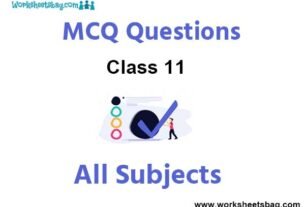Please refer to Linear Inequalities MCQ Questions Class 11 Mathematics below. These MCQ questions for Class 11 Mathematics with answers have been designed as per the latest NCERT, CBSE books, and syllabus issued for the current academic year. These objective questions for Linear Inequalities will help you to prepare for the exams and get more marks.
Linear Inequalities MCQ Questions Class 11 Mathematics
Please see solved MCQ Questions for Linear Inequalities in Class 11 Mathematics. All questions and answers have been prepared by expert faculty of standard 11 based on the latest examination guidelines.
MCQ Questions Class 11 Mathematics Linear Inequalities
Question: For all x,x2+2ax+(10-3a)>0, then the interval in which a lies, is
(a) a < – 5
(b) – 5<a<2
(c) a > 5
(d) 2<a < 5
Answer
B
Question: If the roots of the equation x2-2ax+a2+a-3=0 are real and less than 3
(a) a < 2
(b) 2≤ a ≤3
(c) 3< a ≤ 4
(d) a > 4
Answer
A
Question: If α and β be the roots of the quadratic equation ax2+ bx+ c=0 and k be a real number, then the condition, so that α <k<β is given by
(a) ac > 0
(b) ak2+bk+c=0
(c) ac < 0
(d) a2k2+abk+ac<0
Answer
D
Question: The values of ‘a’ for which (a2-1)x2+2(a-1)x+2 is positive for any x, are
(a) a ≥ 1
(b) a ≤1
(c) a > – 3
(d) a < – 3 or a > 1
Answer
D
Question: If x2+2ax+b≥c,∀x∈ R, then
(a) b -a ≥ a2
(b) c -a b ≥ b2
(c) a- b≥ c2
(d) None of these
Answer
A
Question: One lies between the roots of the equation -x2+ax+a=0,a∈R if and only if a lies in the interval
(a) (1/2,∞)
(b)(-1/2,∞)
(c) (-∞,1/2)
(d)(-∞,1/2)
Answer
A
Question: If α and β (α <β ) are the roots of the equation x2+bx+c=0 where c <0 <b, then
(a) 0 <α <β
(b) α<0<β <|α|
(c) a<β < 0
(d) a<0<|α|<β|
Answer
B
Question: The solution set of 1≤|x-2|≤3 is
(a) ( -1,1)∪(3,5]
(b) [-1,1 ]∪ [3,5]
(c) [- 1,1] ∪ [3 ,5 )
(d) None of these
Answer
B
Question: The values of a for which 2x2-2(2a+1)x+a(a+1)=0 may have one root less than a and other root greater than a are given by
(a) 1>a >0
(b) – 1 < a<0
(c) a ≥0
(d) a > 0 or a < – 1
Answer
D
Question: If the expression (mx-1+1/x) is always non-negative, then the minimum value of m must be
(a) -1/2
(b) 0
(c) 1/4
(d) 1/2 c
Question:

Answer
B
Question: The solution set of |x-2|-1/|x-2|-2≥0 is
(a) [0 ,1 ]∪(3,4)
(b) [ -1,1]∪ [3,4]
(c) [ 0,1] ∪ (3,4)
(d) None of these
Answer
B
Question: The solution set of 2x- 1/3 ≥(3x-2/4) -(2-x/5) is
(a) (4,∞)
(b) [4 ,∞ )
(c) [ -4,4]
(d) (-∞,2]
Answer
D
Question: The solution set of 1≤|x-2|≤3 is
(a) [ -1,1 ] ∪( 3,5 )
(b) (-1 1)∪ [3,5 ]
(c) [ -1, 1] ∪ [3, 5]
(d) [ -1,2] ∪ [3,5]
Answer
C
Question: (x-1)x2-5x+7)<(x-1), then x belongs to
(a) (1, 2) ∪ (3,∞)
(b) (2,3)
(c) (- ∞,1)∪ (2, 3)
(d) None of these
Answer
C
Question: |2x -3|<|x+5|,then x belongs to
(a) (-3, 5)
(b) (5, 9)
(c) (-2/3,8)
(d) -8,2/3)
Answer
C
Question:

Answer
A
Question: If a+b= 8, then ab is greatest when
(a) a=4,b=4
(b) a =3, b=5
(c) a= 6,b=2
(d) None of these
Answer
A
Question: x2-3|x|+ 2<0, then x belongs to
(a) (1, 2)
(b) (-2, -1,)
(c) (-2, -1,)∪(1, 2)
(d) (-3 5, )
Answer
A
Question: If ab=4 (a,b∈R+)then
(a) a+ b ≤ 4
(b) a+ b =4
(c) a+ b ≥ 4
(d) None of these
Answer
C
Question: If x2+6x-27>0 and x2-3x-4>0, then
(a) x > 3
(b) x < 4
(c) 3 <x < 4
(d) x =7/2
Answer
C
Question: x and b are real numbers. If b > 0 and |x| > b, then
(a) x ∈ (–b, ∞)
(b) x ∈ (–∞, b)
(c) x ∈ (–b, b)
(d) x ∈ (–∞, –b) ∪ (b, ∞)
Answer
D
Question: Solution of |x+1/x| > 2 is
(a) R – {0}
(b) R – {–1, 0, 1}
(c) R – {1}
(d) R – {–1, 1}
Answer
B
Question: Match the linear inequalities given in column-I with solution set representing by graphs in column-


Codes:
A B C D
(a) 4 3 2 1
(b) 2 1 4 3
(c) 1 3 4 2
(d) 3 4 2 1
Answer
C
Question: If |x + 3| ≥ 10, then
(a) x ∈(−13,7]
(b) x ∈(−13,7)
(c) x ∈(−∞,13]∪[−7,∞)
(d) x ∈(−∞, −13]∪[7,∞)
Answer
D
ASSERTION – REASON TYPE QUESTIONS
(a) Assertion is correct, reason is correct; reason is a correct explanation for assertion.
(b) Assertion is correct, reason is correct; reason is not a correct explanation for assertion
(c) Assertion is correct, reason is incorrect
(d) Assertion is incorrect, reason is correct.
Question: Assertion : Two real numbers or two algebraic expressions related by the symbol < , >, ≤ or ≥ forms an inequality.
Reason : The inequality ax + by < 0 is strict inequality.
Answer
B
Question: Assertion : If 3x + 8 > 2, then x ∈ {–1, 0, 1, 2, …}, when x is an integer.
Reason : The solution set of the inequality 4x + 3 < 5x + 7 ∀ x ∈ R is [4, ∞).
Answer
C
Question: Assertion : The region containing all the solutions of an inequality is called the solution region.
Reason : The values of x, which make an inequality a true statement, are called solutions of the inequality.
Answer
B
Question: Assertion : If a < b, c < 0, then a/c < b/c.
Reason : If both sides are divided by the same negative quantity, then the inequality is reversed.
Answer
D
Question: Assertion : The inequality 3x + 2y ≥ 5 is the linear inequality.
Reason : The solution of 5x – 3 < 7, when x is a real number, is (–∞, 2).
Answer
B
Question: Assertion : A non-vertical line will divide the plane into left and right half planes.
Reason : The solution region of a system of inequalities is the region which satisfies all the given inequalities in the system simultaneously.
Answer
D


